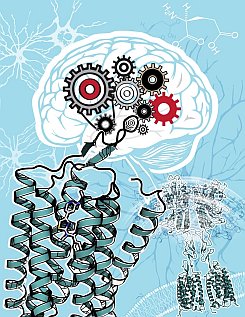 |
Figure: Artist's rendering of metabotropic glutamate receptor 1 (courtesy of TSRI). |
The group of Ray Stevens at The Scripps Research Institute and collaborators at Vanderbilt University determined the structure of Class C GPCR metabotropic glutamate receptor 1 bound to an allosteric modulator. This important receptor is linked to learning, memory, anxiety, pain and brain disorders and is a potential target for drugs against cancer, chronic pain, schizophrenia, Parkinson's, Alzheimer's and autism. Glutamate receptors are classified as ionotropic or metabotropic. Ionotropic glutamate receptors (iGluRs) act rapidly to form an ionic pore when the neurotransmitter glutamate is bound; metabotropic glutamate receptors (mGluRs) are associated with a more prolonged stimulus and act via a G-protein signaling cascade. This is the first mGluR structure and also the first Class C GPCR structure. Class C GPCRs form dimers mediated by a large N-terminal extracellular domain, which was not present in the crystallized construct. Nevertheless the transmembrane domain crystallized as a dimer, mediated in part by cholesterol. In contrast to other GPCRs, the entrance to the allosteric binding site, which is considered ripe for targeting drugs that modulate activity, is almost completely covered by loops. The structural template will help to guide challenging pharmaceutical design to reach this site.
Citation: Wu, H, Wang, C, Gregory, KJ, Han, GW, Cho, HP, Xia, Y, Niswender, CM, Katrich, V, Meiler, J, Cherezov, V, Conn, PJ, Stevens, RC. Structure of a class C GPCR metabotropic glutamate receptor 1 bound to an allosteric modulator, Science 344, 58-64 (2014).